
Testking_640-802_V13
.pdf
Number of Bits in the Host or |
Maximum number of Hosts or |
Subnet Field |
Subnets (2n-2) |
|
|
1 |
0 |
|
|
2 |
2 |
|
|
3 |
6 |
|
|
4 |
14 |
|
|
5 |
30 |
|
|
6 |
62 |
7 |
126 |
|
|
8 |
254 |
|
|
9 |
510 |
|
|
10 |
1022 |
|
|
11 |
2046 |
12 |
4094 |
|
|
13 |
8190 |
|
|
14 |
16,382 |
|
|
With 9 bits used for the subnet portion, we get 510 subnets and using the remaining 7 bits for the hosts gives us 126 hosts per subnet. The subnet mask will be 255.255.255.128
With 10 bits used for the subnet portion, we get 1022 subnets and then using the remaining 6 bits for hosts provides 62 hosts per subnet. The subnet mask will be 255.255.255.192 in this case which will also fulfill the requirement.
QUESTION NO: 17
A TestKing PC has the IP address 172.16.209.10 /22. What is the subnet of this address?
A.172.16.42.0
B.172.16.107.0
C.172.16.208.0
D.172.16.252.0
E.172.16.254.0
Answer: C
Leading the way in IT testing and certification tools, www.testking.com
- 321 -

Explanation:
172.16.209.10/22 translates to 10101100.00010000.11010001.00001010 in binary form. The network portion is 22 bits, so after the logical AND comparison the network address translates to10101100.00010000.110100001.00001010. Converting the network portion to decimal results in the address 172.16.208.0/22
QUESTION NO: 18
You've been assigned the CIDR (classless inter domain routing) block of 115.64.4.0/22 from your ISP. Which of the IP addresses below can you use for a host? (Select all valid answers)
A.115.64.8.32
B.115.64.7.64
C.115.64.6.255
D.115.64.3.255
E.115.64.5.128
F.115.64.12.128
Answer: B, C, E Explanation:
115.64.4.0 = 01110011.01000000.00000100.00000000
Subnet mask = 11111111.11111111.11111100.00000000= 255.255.252.0 Subnet number = 01110011.01000000.00000100.00000000= 115.64.4.0 Broadcast = 01110011.01000000.00000111.11111111= 115.64.7.255
Valid address range = 115.64.4.1 - 115.64.7.254
QUESTION NO: 19
A TestKing remote office branch is set up as shown in the diagram below:
Leading the way in IT testing and certification tools, www.testking.com
- 322 -
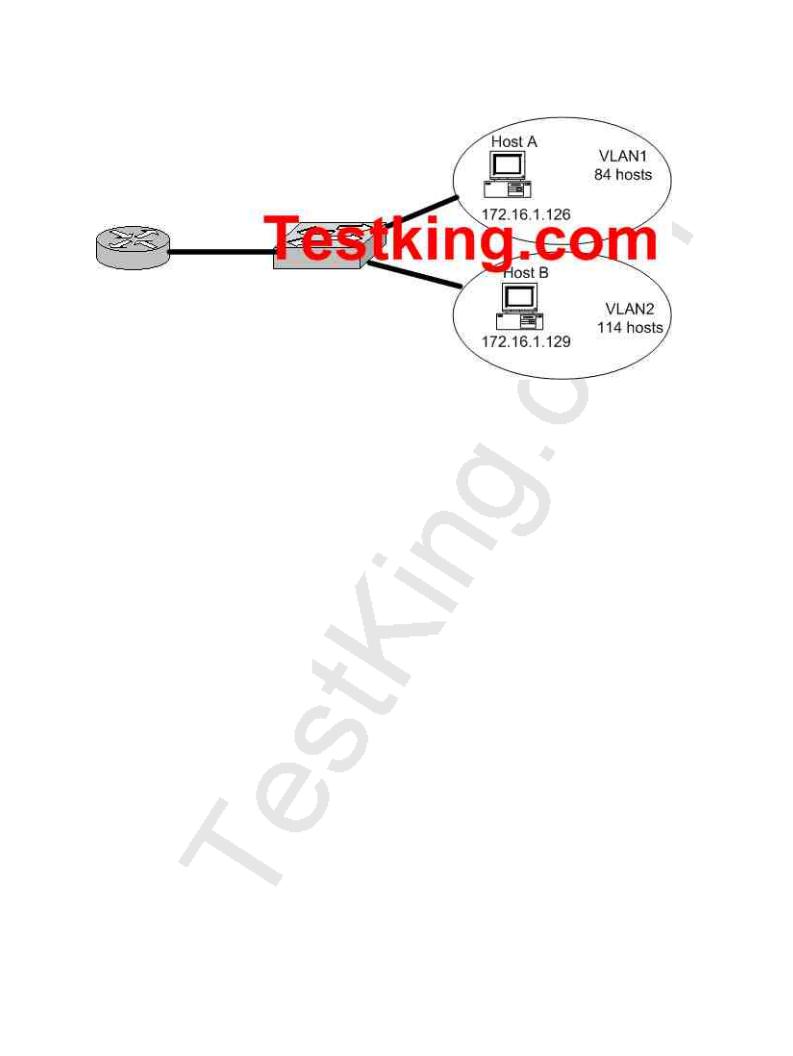
All of the hosts in the above exhibit are connected with each other via the single Catalyst switch. Which of the following statements correctly describe the addressing scheme of this network? (Select three)
A.The subnet mask in use is 255.255.255.192.
B.The subnet mask in use is 255.255.255.128.
C.The IP address 172.16.1.25 can be assigned to hosts in VLAN1.
D.The IP address 172.16.1.205 can be assigned to hosts in VLAN1
E.The LAN interface of the router is configured with one IP address.
F.The LAN interface of the router is configured with multiple IP addresses.
Answer: B, C, F Explanation:
Based on the diagram above, the subnet mask used for each VLAN is 255.255.255.128. This means that hosts in VLAN 1 will be addressed 172.16.1.1-172.16.1.126, with 172.16.1.127 being used as the broadcast address. Hosts in VLAN 2 will be addressed 172.16.1.129-172.16.1.254. Because there is only one LAN interface on the router, sub interfaces will be used, so the router's LAN interface will be configured with 2 IP addresses, one for VLAN 1 and 1 for VLAN 2.
Incorrect Answers:
Leading the way in IT testing and certification tools, www.testking.com
- 323 -

A. This subnet mask will only provide 62 host IP addresses, and the diagram shows that as many as 114 host IP addresses are needed.
D.This IP address can be used in VLAN 2, not VLAN 1.
E.Since there are 2 subnets in this network, each separate network will require a distinct default gateway IP address, so 2 IP addresses will be required on the LAN interface of the router.
QUESTION NO: 20
On the topic of VLSM, which one of the following statements best describes the concept of the route aggregation?
A.Deleting unusable addresses through the creation of many subnets.
B.Combining routes to multiple networks into one supernet.
C.Reclaiming unused space by means of changing the subnet size.
D.Calculating the available host addresses in the AS.
E.None of the above
Answer: B Explanation:
In the networking world route aggregate means combining routes to multiple networks into one. This is also known as route summarization or supernetting. It is normally used to reduce the number of route entries in the routing table by advertising numerous routes into one larger route.
Reference: CCNA Self-Study CCNA ICND exam certification Guide (Cisco Press, ISBN 1-58720-083-X) Page 236.
QUESTION NO: 21
In the TestKing network shown below, what is the most efficient summarization that TK1 can use to advertise its networks to TK2?
Leading the way in IT testing and certification tools, www.testking.com
- 324 -
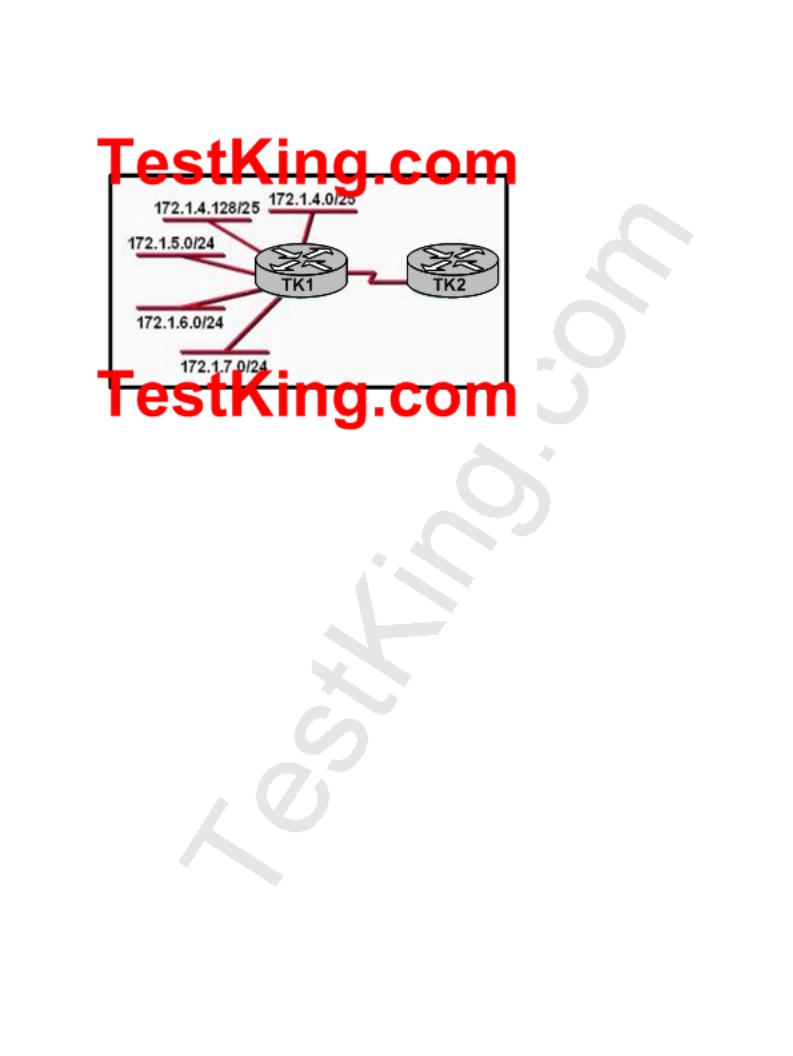
A.172.1.4.0/24172.1.5.0/24172.1.6.0/24172.1.7.0/24
B.172.1.0.0/22
C.172.1.4.0/25172.1.4.128/25172.1.5.0/24172.1.6.0/24172.1.7.0/24
D.172.1.0.0/21
E.172.1.4.0/22
Answer: E Explanation:
Route Summarization Overview:
In large internetworks, hundreds, or even thousands, of network addresses can exist. It is often problematic for routers to maintain this volume of routes in their routing tables. Route summarization (also called route aggregation or supernetting) can reduce the number of routes that a router must maintain, because it is a method of representing a series of network numbers in a single summary address.
Leading the way in IT testing and certification tools, www.testking.com
- 325 -
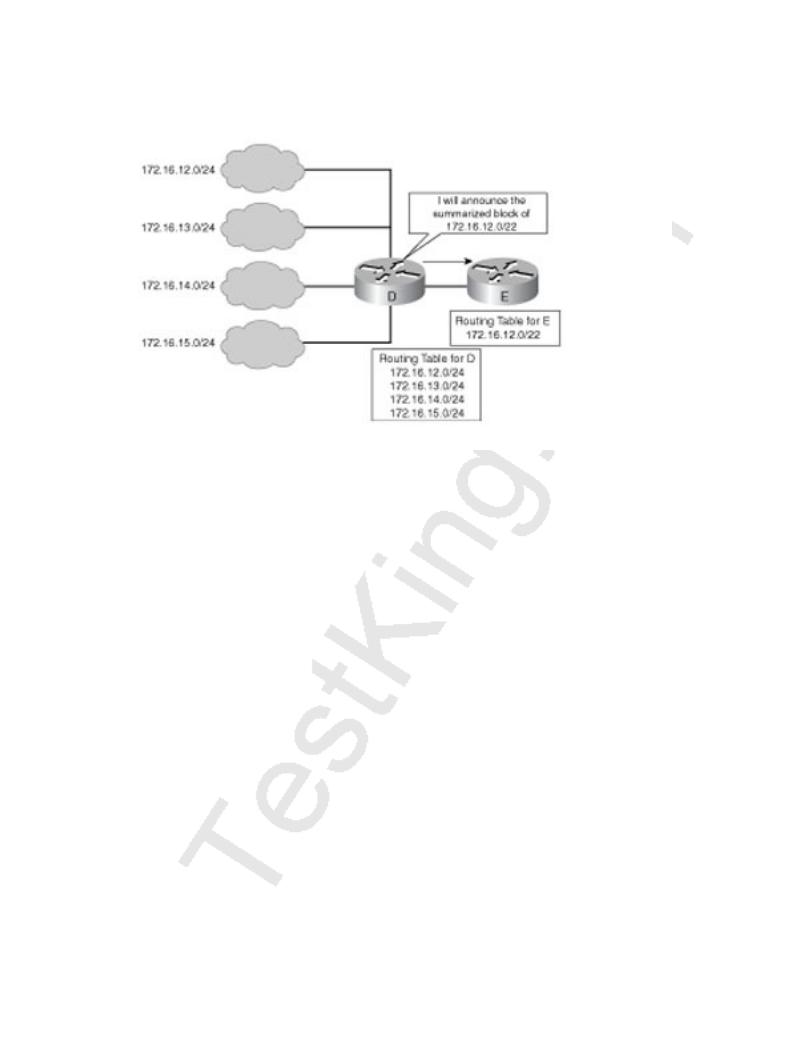
For example, in the figure above, router D can either send four routing update entries or summarize the four addresses into a single network number. If router D summarizes the information into asingle network number entry, the following things happen:
1.Bandwidth is saved on the link between routers D and E.
2.Router E needs to maintain only one route and therefore saves memory.
3.Router E also saves CPU resources, because it evaluates packets against fewer entries in its routing table.
A summary route is announced by the summarizing router as long as at least one specific route in its routing table matches the summary route.
QUESTION NO: 22
Part of the TestKing network is shown below:
Leading the way in IT testing and certification tools, www.testking.com
- 326 -
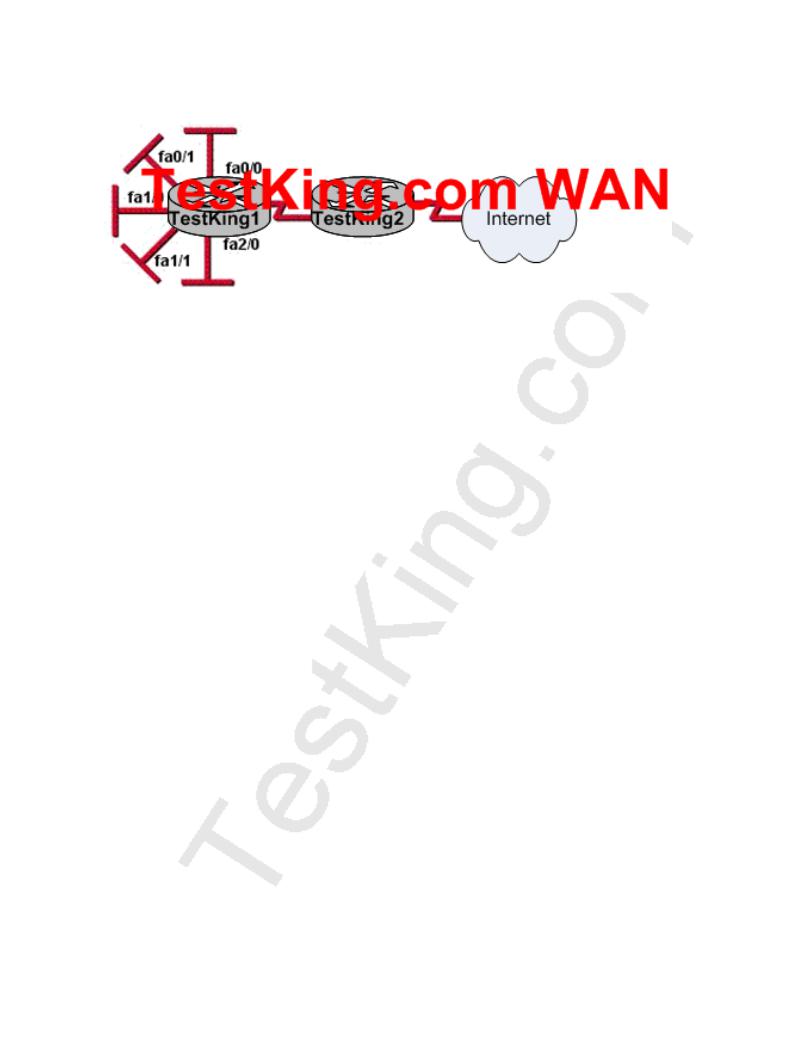
The five Ethernet networks connected to router TestKing1 in the graphic have been summarized for router TestKing2 as 192.1.144.0/20. Based on this information, which of the following packet destination addresses will TestKing2 forward to TestKing1, according to this summary? (Choose two.)
A.192.1.1.144
B.192.1.159.2
C.192.1.138.41
D.192.1.151.254
E.192.1.160.11
F.192.1.143.145
G.0.0.0.0
Answer: B, D
QUESTION NO: 23
Refer to the following exhibit:
Leading the way in IT testing and certification tools, www.testking.com
- 327 -
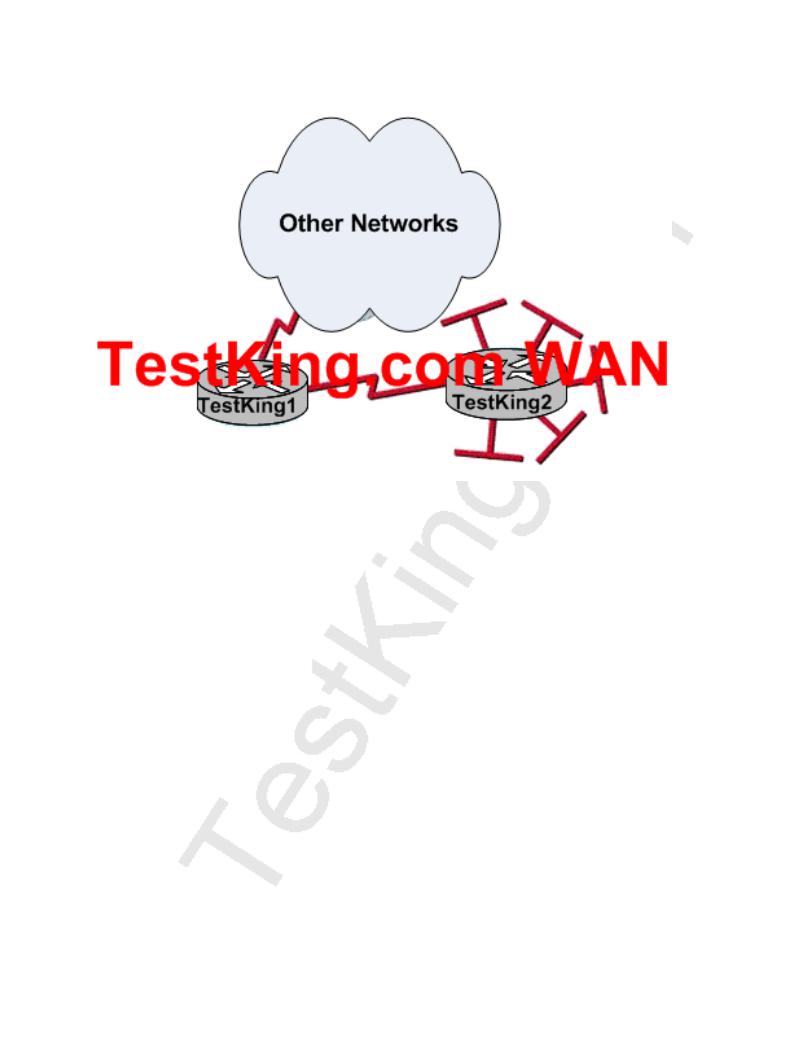
In this network segment, the IP subnets connected to router TestKing2 have been summarized as a 192.18.176.0/21 route and sent to TestKing1. Based on this information, which two packet destination addresses will TestKing1 forward to TestKing2? (Choose two)
A.192.18.183.255
B.192.18.159.2
C.192.18.194.160
D.192.18.179.4
E.192.18.183.41
F.192.18.184.45
Answer: D, E
QUESTION NO: 24
What is the subnet address of the host with an IP address of 172.16.159.159/22?
A. 172.16.128.0
Leading the way in IT testing and certification tools, www.testking.com
- 328 -

B.172.16.156.0
C.172.16.159.128
D.172.16.159.0
E.172.16.192.0
F.172.16.0.0
G.None of the above
Answer: B Explanation:
In this question there are a total of 6 bits borrowed from the host portion with the subnet mask 255.255.252.0. This will leave us 64 networks with 1022 and the IP subnets for each will be a multiple of 4. Some of the networks are as follows:
/22 172.16.148.0 - 255.255.252.0 - 1022 hosts /22 172.16.152.0 - 255.255.252.0 - 1022 hosts
/22 172.16.156.0 - 255.255.252.0 - 1022 hosts
/22 172.16.160.0 - 255.255.252.0 - 1022 hosts /22 172.16.164.0 - 255.255.252.0 - 1022 hosts /22 172.16.168.0 - 255.255.252.0 - 1022 hosts /22 172.16.172.0 - 255.255.252.0 - 1022 hosts /22 172.16.176.0 - 255.255.252.0 - 1022 hosts
Section 7: Describe the technological requirements for running IPv6 in conjunction with IPv4 (including: protocols, dual stack, tunneling, etc). (0 questions)
Section 8: Describe IPv6 addresses (1 question)
QUESTION NO: 1
TestKing is migrating to an IPv6 addressing scheme. Identify the four valid IPv6 addresses below that could be used in this network. (Choose four)
A. ::192:168:0:1
Leading the way in IT testing and certification tools, www.testking.com
- 329 -

B.2002:c0a8:101::42
C.2000::
D.::
E.2001:3452:4952:2837::
F.2003:dead:beef:4dad:23:46:bb:101
Answer: A, B, D, F
Explanation:
From RFC 1884: IP Version 6 Addressing Architecture
There are three conventional forms for representing IPv6 addresses as text strings:
1. The preferred form is x:x:x:x:x:x:x:x, where the 'x's are the hexadecimal values of the eight 16-bit pieces of the address. Examples:
FEDC:BA98:7654:3210:FEDC:BA98:7654:3210
1080:0:0:0:8:800:200C:417A
Note that it is not necessary to write the leading zeros in an individual field, but there must be at least one numeral in every field (except for the case described in 2.).
2. Due to the method of allocating certain styles of IPv6 addresses, it will be common for addresses to contain long strings of zero bits. In order to make writing addresses
containing zero bits easier a special syntax is available to compress the zeros. The use of "::" indicates multiple groups of 16-bits of zeros. The "::" can only appear once in an address. The "::" can also be used to compress the leading and/or trailing zeros in an address.
For example the following addresses:
1080:0:0:0:8:800:200C:417A a unicast address FF01:0:0:0:0:0:0:43 a multicast address 0:0:0:0:0:0:0:1 the loopback address 0:0:0:0:0:0:0:0 the unspecified addresses
Leading the way in IT testing and certification tools, www.testking.com
- 330 -
